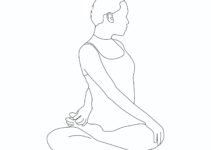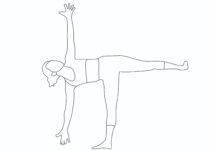Yoga is a science of healthy living that focuses on bringing harmony between body and mind. Yoga’s preventive aspects are pretty productive. Yoga acts as a panacea for diseases like lifestyle-related disorders and psychosomatic disorders. Being a drugless therapy, it is cost-effective and safe and enhances the body’s functional ability. However, practising yoga exercises brings negative results in many conditions, too. The system is also not entirely free from side effects.
Side Effects of Yoga
Precaution is of utmost importance while doing yoga. If yoga practices or exercises are not performed correctly, there is a greater possibility of side effects. Doing yoga unsystematically can aggravate the problems rather than showing its positive health benefits. So, it is recommended that yoga should always be practised under the guidance of an experienced yoga instructor or therapist. If you want to get the most benefits of yoga, it is better to perform yogic practices in a sequence: Kriyas (cleansing process), Yogasanas, Pranayama, Bandha, and Meditation. A peaceful milieu is advisable for yoga as it helps to bring positive results to the mind, body, and soul.
Yoga Precautions
Yoga should always be practised on an empty stomach. It is suggested to practice yoga after 4-5 hours of meals. Light clothes should be used while performing yoga. Perform yogic practices in a relaxed mood. Overstretched and over-strained should not be a part of yoga. To perform yoga in a chronic condition, it is strictly advisable to consult yoga physicians. Proper procedures should be followed for practising yoga. Yoga in an improper fashion may lead to negative results. You are not in a race or competition with other people, so go slow with yoga to have its proper benefits.
If the person is experiencing constipation, it is advisable to empty your bowel by doing some standing stretching asanas like Tadasana, Hasttotanasana, and left-right stretch bending to evacuate your intestine.
Restrictions in Yoga
The practice of yoga may show reverse impacts when the person is drunk. Yoga is a refreshing technique where the intake of beverages like alcohol, coffee, tea, smoking, gutka, pan masala, fried food, spicy food, soft drinks, etc., are discouraged as these may lead to stress and strain because of toxin production. Asanas also shouldn’t be practised in conditions like fractured bones and diseases like ulcers, tuberculosis, and hernia.
Adverse Effects of Yoga Exercises
Yogasanas should also be avoided by patients suffering from heart disease, high blood pressure, or other chronic diseases. Practising yoga in conditions like chronic osteoporosis, high blood pressure (H/L), spine problems, pregnancy, and ear problems may intensify or aggravate these conditions. Yoga shouldn’t be performed after heavy exercises. At least half an hour gap should be maintained after strenuous workouts for practising yoga. Overstretching and strain in the neck, shoulders, spine, legs, and muscles are common as yoga injuries. Special precautions should be taken during pregnancy. Pregnant women should perform yoga only under the guidance of an experienced yoga therapist.
When Yoga Should Not Be Done?
Though yoga is one of the best healthcare systems, in some cases, practising yoga should be avoided. Practising yoga in such cases may lead to adverse reactions and can show negative results. Tadasana shouldn’t be practised for chronic cardiac problems. Pregnant women should practice it under strict supervision. Trikonasana should be avoided in acute backache conditions. Padmasana may aggravate arthritis, slipped disks, and injuries. Pregnant women and persons who are suffering from peptic ulcer, hernia, arthritis, and cardiac problems should avoid this yoga. Utmost precautions should be taken by people experiencing high blood pressure, abdominal inflammation, ulcers, vertigo, and high myopia while performing Chakrasana. Adverse reactions may happen while performing Sirsasana with persons having high blood pressure, heart disease, and cervical spondylitis. Someone with an ulcer, appendicitis, colitis, hernia, or peptic ulcer should avoid Dhanurasana.
Contra-indication in Yoga Practices
Performing yoga in some circumstances may show adverse effects. Therefore, some yoga asanas shouldn’t be achieved in severe disease conditions to maintain yoga safety. Gomukhasana should be avoided in conditions like piles and arthritis. Precautions should be taken for those with banks, stiff joints, uric acid, and ankle and knee injuries while performing vajrasana. Ardhamatsyendrasana shows contradictory effects in the case of a rigid spine, pregnancy, backache, arthritis, and abdominal problems. Contra-indications are also related to Pascimottanasana, as this yoga should be avoided by people who have experienced abdominal ulcers and abdominal inflammations. Ustrasana may also show an adverse reaction with high blood pressure, heart disease, and hernia. Suptvajrasana shouldn’t be practised by people who are having gastric problems. Precautions should also be taken in other yoga exercises like Sarvangasana, Utkatasana, Sasankasana, Mandukasana, Salabhasana, Bhujangasana, Halasana and Pavanmuktasana.
Precautions for Yoga Kriyas (Shatkarma)
While performing Kunjal, drink water in a sitting posture. Lukewarm water should be preferred, and the kriyas should be completed with an empty bowel. The cleansing process Kunjal should also not be practised by people with heart disease and high blood pressure. Jalabasti (Yogic enema with water) should be done on an empty stomach. Jalabasti shouldn’t be practised in case of rectal bleeding and diarrhoea. Sutraneti (nasal cleansing with thread) should be avoided in case of nose bleeding. While performing Jalaneti (nasal cleansing with water), precautions should be taken so that water doesn’t enter the ear—an appropriate quantity of salt to be added during Jalaneti. A person who has glaucoma and chronic eye disorders shouldn’t perform Trataka. Nauli (Rotating the stomach) may show adverse effects in the case of a person suffering from heart disease, hernia, hypertension, and gastric ulcer. Kapalabhati should be avoided by persons suffering from cardiac conditions, giddiness, high blood pressure, vertigo, and gastric ulcers.
Side Effects of Pranayama
Pranayama should be avoided by those people who are facing breathing problems. Chronic patients shouldn’t hold their breath during Pranayama. Pranayama should be practised in a well-ventilated place. An empty stomach, evacuated bowel, and bladder are needed for performing pranayama. Practising pranayama after a bath is beneficial as it facilitates uniform blood circulation throughout the body. During Pranayama, breathing should be slow and rhythmic. Retention of breath should be avoided in Nadisodhana Pranayama. People with high blood pressure shouldn’t perform Suryabhedhana Pranayama. People with low blood pressure should not practice Ujjai Pranayama. Precautions must be taken in case of hypertension and cardiac problems. Persons suffering from colds, coughs, and having acute constipation should not perform Sitkari Pranayama. Sitali Pranayama shows adverse results when served with cold, cough, and tonsillitis. Bhastrika Pranayama shouldn’t be practised when the person has high blood pressure, heart disease, brain tumours, and ulcers. If you have ear problems, Bhramari Pranayama should be avoided.






Yogasanas can change your body shapes
-some yogagurus claims that tadasanas,paschimottanasana can increase height and give a V shaped body,but it’s not the case . Talking about my personal experience I have done these things religiously for 2 years and what they have done to me are like my height just stopped around 2 months after starting these ####.
I was 14 only that time ,so what these asanas do are like they starts to develop your lower body weight nothing else . So I think that you can give a try to pranayama not asanas at your growing phase
Please explain why pawanmuktasana is contraindicated in case of piles
Is kapalbhti harmful in glaucoma?
I don’t think so because kapalbhati is best for nose ear and eye problem. Yo should do it